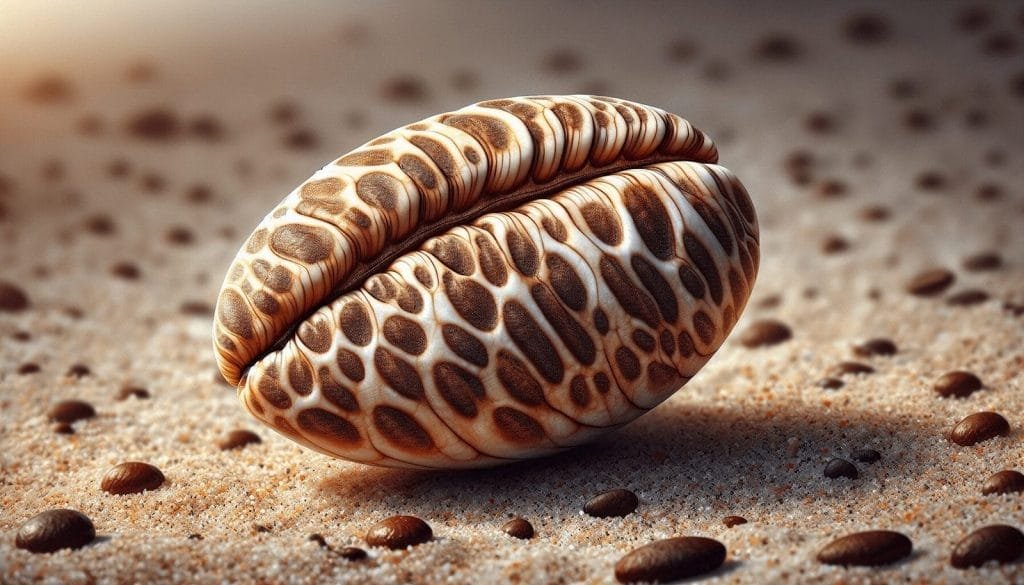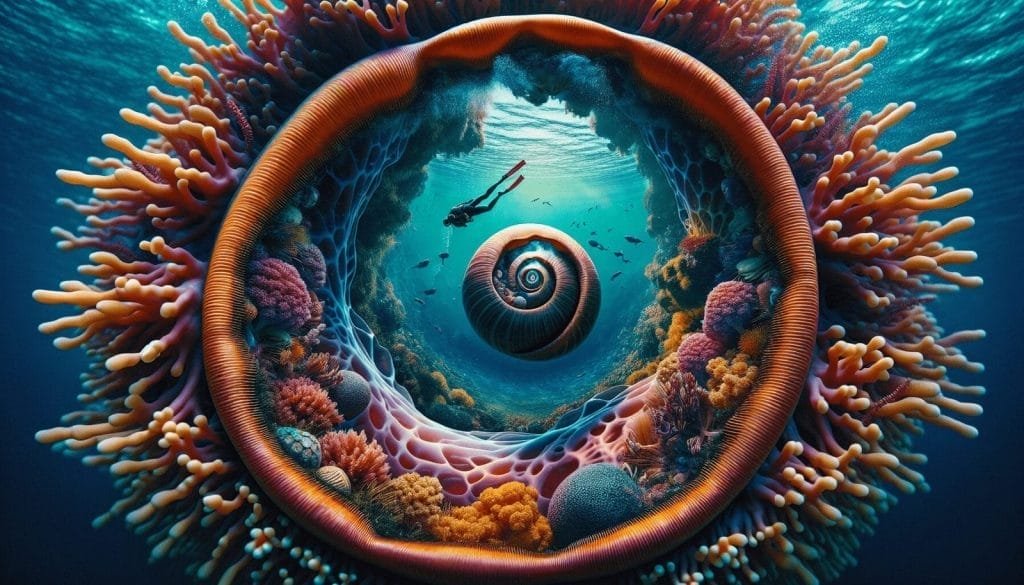Imagine walking along a sandy beach, feeling the warmth of the sun on your skin and the gentle breeze tousling your hair. As you stroll, you come across a peculiar shell, resembling a delightful coffee bean. Its smooth, curved shape and rich, earthy color immediately capture your attention. But what is this enigmatic shell? Where does it come from? In this article, we will uncover the secrets behind this unique natural marvel and delve into its fascinating characteristics that make it stand out among its oceanic peers. Prepare to be intrigued and amazed as we shine a spotlight on the shell that looks like a coffee bean.

Types of Shells
Cone shell
The cone shell, also known as Conidae, is a type of seashell that is characterized by its cone-like shape. These shells can vary in size and color, and are often found in tropical marine environments. The cone shell is well-known for its venomous properties, making it a fascinating and dangerous creature.
Moon shell
The moon shell, also known as Naticidae, is a unique and beautiful seashell that resembles the shape of a crescent moon. These shells are often found in sandy or muddy bottoms of shallow waters. With their distinct round shape and intricate patterns, moon shells are highly sought after by collectors and beachcombers alike.
Cappuccino shell
The cappuccino shell, also known as Tonna galea, is a large and stunning seashell that resembles the color and pattern of a cappuccino. These shells are typically found in marine environments with sandy or muddy bottoms. With their bold and earthy colors, cappuccino shells are a popular choice for decorative purposes.
Physical Description
Size and shape
Cone shells are typically small to medium-sized shells, ranging from a few centimeters to around 15 centimeters in length. Their shape is conical, tapering to a point at one end. Moon shells are generally medium-sized shells, growing up to 5 centimeters in diameter. They have a round, dome-like shape with a smooth exterior. Cappuccino shells, on the other hand, are large shells that can reach lengths of up to 30 centimeters. They have a thick, elongated shape with a wide opening.
Color and pattern
Cone shells can come in a variety of colors, ranging from vibrant and striking, to more muted and earthy tones. They often showcase intricate patterns, such as stripes, dots, or spirals, which add to their visual appeal. Moon shells, on the other hand, have a smooth and glossy surface with a range of colors including white, beige, brown, and even shades of pink or purple. These shells often have unique patterns and markings that make each one truly unique. Cappuccino shells, true to their name, have a beautiful blend of brown and beige colors, resembling the appearance of a freshly brewed cappuccino. Their surface is often adorned with fine lines or grooves, giving them a textured and visually interesting look.
Habitat
Marine environments
All three types of shells – cone shells, moon shells, and cappuccino shells – are found in marine environments. They thrive in the saltwater habitats of oceans and seas around the world. These shells are often discovered along coastlines or washed up on beaches, as they are swept onto shore by the tides.
Shallow waters
Cone shells, moon shells, and cappuccino shells are typically found in shallow waters. They prefer the intertidal zone, which is the area that is covered and uncovered by water during the tidal cycle. This zone provides them with the ideal conditions for survival, including ample access to food and protection from strong waves and currents.
Sandy or muddy bottoms
One common characteristic of all three types of shells is their preference for sandy or muddy bottoms. These shells are often found buried in the soft sediment, partially or completely hidden from view. This habitat provides them with protection and camouflage, making it easier for them to evade predators and capture their prey.
Diet and Feeding
Predatory behavior
Cone shells are known for their predatory behavior. They are carnivorous creatures that primarily feed on small marine organisms such as fish, worms, and other mollusks. These shells use a venomous harpoon-like tooth called a radula to immobilize and capture their prey. Once the prey is injected with venom, the cone shell can devour it at its own leisure.
Prey selection
Moon shells are also carnivorous, but they have a slightly different feeding strategy. They primarily feed on bivalves, which are a type of mollusk with two hinged shells. The moon shell uses its strong foot to pry open the bivalve’s shells, allowing it access to the soft and nutritious flesh inside. Cappuccino shells, on the other hand, are filter feeders. They use their long siphon to draw in water, filtering out small organisms such as plankton and other microscopic creatures for nourishment.

Reproduction and Life Cycle
Sexual reproduction
All three types of shells reproduce through sexual reproduction. They have separate male and female individuals, and reproduction occurs when sperm from a male shell fertilizes the eggs of a female shell. This process typically occurs in the water, allowing the fertilized eggs to develop and hatch in their natural marine environment.
Egg-laying habits
Cone shells and moon shells are oviparous, meaning they lay eggs. The female shell will release eggs into the water, which are then fertilized by nearby males. The eggs are equipped with protective jelly coatings to increase their chances of survival. Cappuccino shells, on the other hand, are ovoviviparous. This means that the female retains the fertilized eggs internally until they hatch into fully formed juveniles. After hatching, the young shells are released into the water.
Development stages
Upon hatching, the cone shell larvae, known as veligers, undergo a period of floating in the water before settling on a suitable substrate. Once settled, they undergo a metamorphosis into miniature versions of adult cone shells. Moon shells and cappuccino shells follow a similar pattern of development, with their larvae going through various stages of growth and development before becoming fully formed individuals.
Defensive Mechanisms
Venomous properties
One of the most fascinating features of cone shells is their venomous properties. The venom contained within their harpoon-like tooth is extremely potent and highly specialized. While cone shells use this venom to capture and paralyze their prey, it also serves as a self-defense mechanism. When threatened, the cone shell can deliver a venomous sting to deter potential predators.
Shell features
In addition to their venomous properties, cone shells have evolved various shell features to protect themselves. Their conical shape provides them with a sturdy and robust structure, making it difficult for predators to break through. Some cone shells also have spines or protrusions on their shell surface, further deterring predators from attacking. Moon shells, with their round and smooth shell shape, rely on camouflage to avoid detection by predators. Their pattern and coloration blend with the sandy or muddy bottoms, allowing them to blend seamlessly into their surroundings. Cappuccino shells, with their large size and thick shell, have the advantage of sheer physical strength as their defense mechanism.

Ecological Importance
Ecosystem interactions
Cone shells, moon shells, and cappuccino shells play important roles in their respective ecosystems. As predators, they help to control the population of small marine organisms, maintaining a balance within the food chain. Their presence also provides a food source for larger predators, ensuring that the energy and nutrients within the ecosystem are efficiently utilized.
Role in food chain
Due to their predatory nature, cone shells are considered to be a keystone species in some marine ecosystems. Their presence or absence can have a significant impact on the overall structure and functioning of the ecosystem. Moon shells and cappuccino shells, while not necessarily keystone species themselves, still contribute to the biodiversity and ecological dynamics of their habitats.
Human Use
Shell collecting
All three types of shells – cone shells, moon shells, and cappuccino shells – are highly sought after by shell collectors. Their unique shapes, patterns, and colors make them prized possessions for those who appreciate the beauty of nature. Shell collecting has become a popular hobby worldwide, with enthusiasts scouring beaches and coastal areas in search of these elusive treasures.
Decorative purposes
The beauty of cone shells, moon shells, and cappuccino shells has not gone unnoticed by artists and craftsmen. These shells have been used for centuries in decorative arts and crafts. From jewelry-making to mosaic art, these shells add a touch of natural elegance to various creations. Their unique patterns and colors make them a favorite choice for designers seeking inspiration from the ocean.

Conservation Status
Threats and challenges
While these shells continue to captivate us with their beauty, they face numerous threats and challenges in their natural habitats. Habitat destruction and pollution, caused by human activities such as coastal development and industrial pollution, pose a significant risk to their survival. Overexploitation through shell collecting also poses a threat, as it can disrupt the natural balance of ecosystems and reduce populations.
Protection efforts
Efforts to protect cone shells, moon shells, and cappuccino shells include the establishment of marine protected areas, which provide a safe haven for these organisms to thrive. Conservation organizations also work to raise awareness about the importance of preserving these shells and their habitats. Sustainable shell collecting practices, such as only collecting empty shells and not disturbing live specimens, are encouraged to ensure the long-term survival of these unique creatures.
Interesting Facts
Symbolism and cultural significance
Shells, including cone shells, moon shells, and cappuccino shells, have held symbolic and cultural significance for centuries. In various cultures around the world, shells have been associated with themes of fertility, protection, and prosperity. They have been used in religious ceremonies, as currency, and as decorative ornaments, representing the deep connection between humans and the natural world.
Notable species
Among the cone shells, one notable species is the geography cone (Conus geographus). This cone shell is particularly venomous and is responsible for several human fatalities. Another notable species is the cowry moon shell (Lunatia heros), which is highly sought after by collectors for its exquisite beauty. In the case of cappuccino shells, the giant tun shell (Tonna galea) is a noteworthy species due to its large size and striking appearance.
In conclusion, cone shells, moon shells, and cappuccino shells are fascinating creatures with unique and captivating characteristics. From their physical descriptions and habitats to their feeding behaviors and ecological importance, these shells offer a glimpse into the wonders of the marine world. While they face threats and challenges, their beauty and cultural significance continue to inspire awe and admiration. Whether collected for decorative purposes or appreciated in their natural habitats, these shells are a testament to the creativity and diversity of our natural world.




